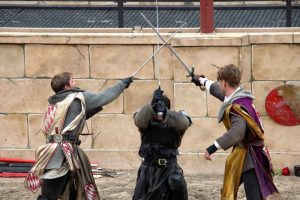Learning to Write Combat

Public domain (https://pxhere.com/en/photo/1215901)
At Foolscap earlier this month, I got to take part in a workshop called “Them’s Fightin’ Words,” which was a workshop about writing combat. This is one of my known weaknesses as a writer–I don’t enjoy reading combat scenes, which means I’m awful at writing them. And while I can get away with just writing stories that don’t need a physical confrontation, my novels, which involve airship pirates, sometimes require a bit of fighting. So do my superhero stories.
Though the workshop was only two hours, I learned a lot. The teacher was Mark Teppo, who I mention frequently when it comes to outlining. He also knows a considerable amount about fighting and choreographing fight scenes for fiction.
While we learned a lot about different weapons and their uses, the parts of the workshop that helped me the most were the ones where we talked about how to translate the knowledge into narrative that conveyed the information and was readable. Here are a few of my notes, in no particular order:
- Knowing enough about the weapon to name it in a specific fashion gives the readers insight into the culture and the character. There’s a difference between drawing a sword (generic) and drawing a rapier (specific), or drawing a gun vs. a 9 mm.
- Knowing what the combatants want out of the fight is key. This could be the death of their opponent, or it could be just slowing them down enough to get away. Or a myriad of other things.
- Following from that, you can use fight scenes to communicate things about a character to the reader. For example, if someone just wants to get away, but are then presented with an opportunity for a killing blow, do they take it, or not? This can also help determine how much detail to include, based on what is important to the character(s) involved.
- Combat is usually way shorter than you would think (especially based on long, drawn-out fight scenes in movies). In general, if a combat goes beyond a couple of passes, either someone has screwed up royally or someone is dead.
- Combat happens so quickly that there isn’t a lot of time for introspection while it’s happening. There should be less thinking and more reacting in the midst of combat.
- Finally, can you tell the story without the fight scene? Does it say more about the character to have the fight scene off-camera and show reactions to the fight by others who were there or heard about it? (And also, how accurate is what they heard?)
The last one was particularly useful to me, because there are times when I could absolutely have the fighting happen off-camera. Hearing that that was an option was fantastic for me!
Aside from these little writing tips, I also learned a bit about fighting with different weapons and in different styles. And apparently, YouTube is full of videos of just about any weapon type or style you can think of. So that’s a valuable resource for writers who want to write about combat, but don’t have the time or inclination to learn how to fight! (And I learned enough to know that the photo I chose to accompany this post is full of awkward reaching and leaving themselves wide open to being hit. And now you know that too, if you didn’t already!)

Comments